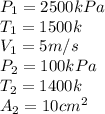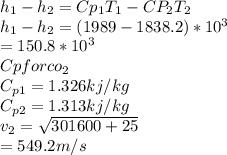
Engineering, 06.07.2021 17:00 kasier4600
CO2 enters an adiabatic nozzle, operating at steady state, at 200 kPa, 1500 K, 5 m/s and exits at 100 kPa, 1400 K. The exit area of the nozzle is 10 cm2. Using the PG model, determine the exit velocity

Answers: 1


Other questions on the subject: Engineering

Engineering, 04.07.2019 18:10, lerasteidl
Determine whether or not it is possible to compress air adiabatically from k to 140 kpa and 400 k. what is the entropy change during this process?
Answers: 3

Engineering, 04.07.2019 18:10, Tyrant4life
Draw the engineering stress-strain curve for (a) bcc; (b) fcc metals and mark important points.
Answers: 1

Engineering, 04.07.2019 18:10, soreese02
An ideal otto cycle with air as the working fluid has a compression ratio of 8. the minimum and maximum temperatures in the cycle are 300 k and 1340 k. use constant specific heats at room temperature to determine (a) the amount of heat transferred to the air during the heat- addition kj/kg, (b) the thermal efficiency, and (c) the thermal efficiency of a carnot cycle ope limits. process, in rating between the same temperature
Answers: 2

Engineering, 04.07.2019 18:10, wirchakethan23
Hydraulic fluid with a sg. of 0.78 is flowing through a 1.5 in. i. d. pipe at 58 gal/min. the fluid has an absolute viscosity of 11.8 x 105 lbf-sec/ft2. is the flow laminar, turbulent or within the critical range? give both a numerical reynolds number and a term answer.
Answers: 3
You know the right answer?
CO2 enters an adiabatic nozzle, operating at steady state, at 200 kPa, 1500 K, 5 m/s and exits at 10...
Questions in other subjects:



Mathematics, 29.01.2020 02:09


Biology, 29.01.2020 02:09


Mathematics, 29.01.2020 02:09

Mathematics, 29.01.2020 02:09




 y=1.4
y=1.4




